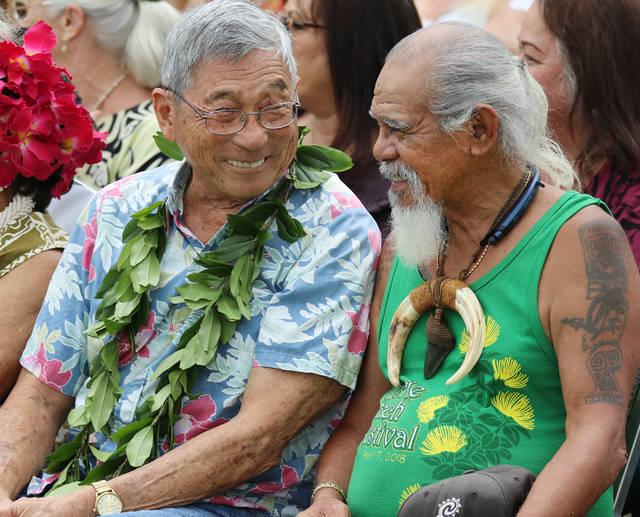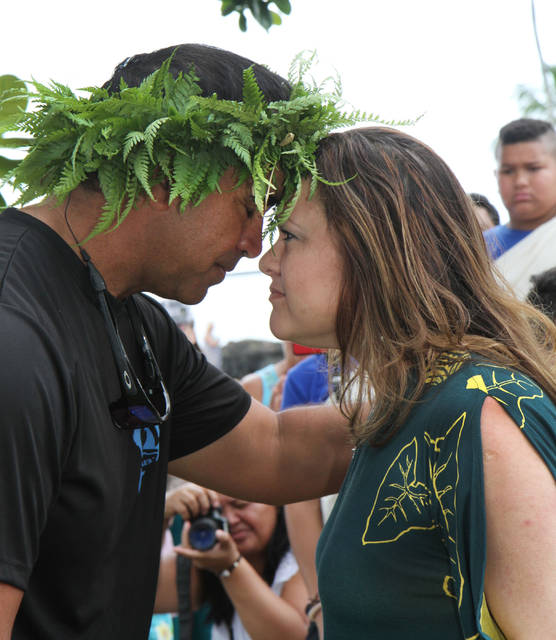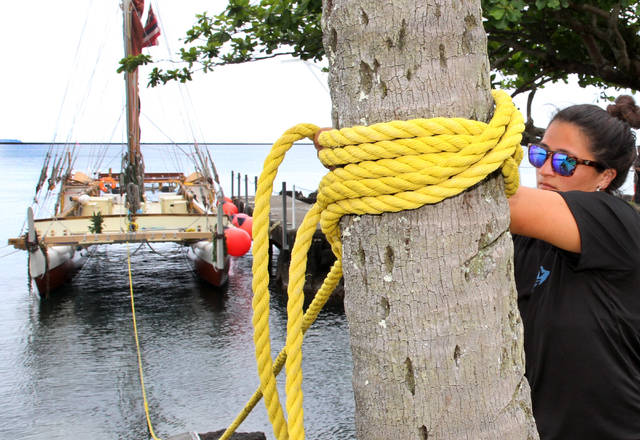A beloved symbol of Hawaii returned to Hilo on Monday when the voyaging canoe Hokule‘a arrived at Kahele Point at the Grand Naniloa Hotel for the first time since 2014.
During a reception Monday, the canoe and its crew were welcomed back to Hilo at the place where it began its worldwide voyage nearly four years ago.
Hokule‘a departed from Hilo in May 2014 on the three-year-long Malama Honua voyage, where it circumnavigated the globe using only traditional Polynesian wayfaring techniques. Throughout the course of its journey, Hokule‘a traveled more than 43,000 nautical miles — nearly 50,000 regular miles — and stopped at more than 150 ports in more than 23 countries.
Although the globe-trotting voyage ended in June 2017, Hokule‘a never returned to Hilo — the final stop on the journey was Magic Island on Oahu. Later that year, however, Hokule‘a started another journey with its sister ship, Hikianalia.
The “Mahalo, Hawaii” voyage takes both canoes to dozens of ports throughout the Hawaiian archipelago, sharing lessons from the Malama Honua voyage with communities and schools. For two months, Hokule‘a and its crew will remain on the Big Island while the Polynesian Voyaging Society discusses the art of sailing with students from around the island.
Hokule‘a made its first voyage in 1976, when it sailed to Tahiti using nothing but starlight for navigation.
“That first crew was set up to fail,” said Kalani Kahalioumi, a Hilo native, rescue swimmer and apprentice navigator aboard Hokule‘a. “They said there was no way you could sail so far using only the stars. But we found the last wayfinder, and he helped us make it there.”
Since then, Hokule‘a has made voyage after voyage throughout Polynesia, and ancient navigational skills have been passed on to new generations, saving a vitally important part of Hawaiian culture from extinction.
After members of the crew disembarked at Monday’s reception, Hawaii County Mayor Harry Kim spoke about the importance of the vessel and its voyage to Hawaiian culture.
“It’s about celebrating, honoring and respecting being Hawaiian,” Kim said. “It’s honoring the extreme pride of the people of Hawaii.”
Another speaker was Ed Bushor, CEO of Tower Development Inc., which oversaw the renovations to the Grand Naniloa. The hotel, formerly the Hilo Naniloa Hotel, was in a state of disrepair when Hokule‘a departed in 2014, Bushor said.
“As they come back, it represents a new beginning,” Bushor said, explaining that those who witnessed the voyage — even guests at the Grand Naniloa — had an opportunity to see what Hawaiian culture means to its people and the rest of the world.
This year “will be the year of the Hawaiians,” said Hawaii County Councilwoman Sue Lee Loy, who, along with the rest of the County Council, presented the crew with a framed certificate honoring their accomplishments.
The reception concluded with a hula demonstration by several Merrie Monarch dancers and live music performances by Lito Arkangel and Paula Fuga, the latter of whom performed Israel Kamakawiwo‘ole’s “Hokule‘a Star of Gladness.”
Hokule‘a will remain in Hilo for the next several weeks for school field trips, while members of the 1976 crew will make a presentation at 1 p.m. April 5 at the ‘Imiloa Astronomy Center. The vessel will be open to the public during a free dockside canoe tour and education expo from 9 a.m.-5 p.m. April 21 at Wailoa Harbor and again from 9 a.m.-2 p.m. May 5 at Kawaihae Harbor.
Email Michael Brestovansky at mbrestovansky@hawaiitribune-herald.com












The late great Mau Pialug of Satawal is the name of the last wayfinder.
KapohoKine Adventures raised $2,500 for the Polynesian Voyaging Society during Hokulea’s Hilo arrival. They took 10 people out on the water in paddleboards and kayaks to greet Hokulea, scatter plumeria and then coordinated on-board tour. All proceeds donated! Way to always support the community!!
Can you explain how they used traditional wayfaring techniques on the Indian Ocean? Is there a traditional chant describing how to find the way there?